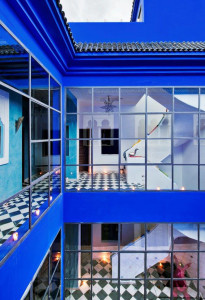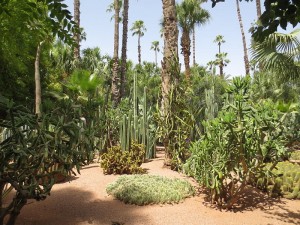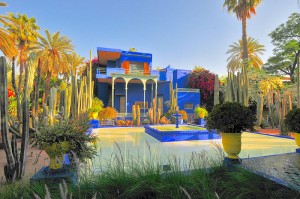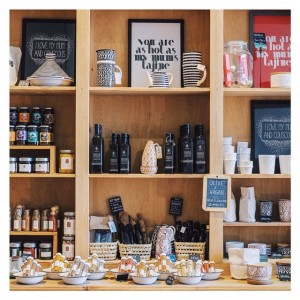Forbes
By Rooksana Hossenally
The first time I visited Marrakech was a few years ago on my way back from Morocco’s Atlas Mountains. Regretfully at the time, the Red City’s charms failed to work on me – in fact it was quite the opposite. Arriving at my hotel in the heart of the sweaty city was a shock to the system, especially after experiencing the easy pace of life up in the gloriously green luxuriant mountains. However, on my second trip to the city a couple of weeks ago, it was like being in a completely different place up to a point where I even wondered if I had really been here before.
My first time in the city I stayed in the medina, the old fortified town centre of labyrinthine narrow streets stemming from the king’s palace in the south. Hawkers lined the streets, pulling and grabbing with their pitiless stares and their requests to “have a look in my shop” tumbling out of their relentlessly moving mouths, one after the other making it impossible to stay and look at the colourful hand-painted ceramics and Moorish style lanterns, leather goods and hand carved wooden home wares.
The experience was made worse by the fact that I fell into every trap that could possibly have been laid out. I accepted the help of a young boy to guide me out of the medina for a few dirham only to be taken the long way around and pestered for a higher tip, I let myself be talked into going to see authentic Berber shops only to arrive at one of the city’s tanneries where I was asked for money to visit. I even negotiated prices in the souks and was fooled into thinking I was standing my ground only to realise I’d paid triple the price for some silver earrings. I even accepted an invitation to have a cup of tea with a shopkeeper in his store, which ended with me running out to the street refusing to buy rugs. Marrakech? I vowed never to set foot in the city again.
However, two years on and there I was, happily gulping down a freshly squeezed orange juice on the main Djema El Fnaa square I had loathed, clinking plastic cups with the bright eyed stall vendor. The sun beat down overhead, the breeze taking off the heat’s prickly edge. The din of music, the clip of horse-drawn carriages, and the laughter of children running around provided the backdrop to my thoughts as I revelled in the serene surroundings.
The hawkers and vendors stayed quiet as I passed through the souks, as though under a spell, as if they knew that I was close to never returning to their beloved city. After meandering the main sights including the Bahia Palace, Saadian Tombs, Medersa Ben Youssef Qu’ranic school, the medina’s pocket-sized Photography Museum, and browsing the sleepy souks, I headed back south towards the Royal Palace.
Bordering its high, freshly painted terracotta walls I entered a smaller red walled medina within the medina that was thankfully stall-free, and made my way to my hotel, the Riad Goloboy. The new riad, the name for a typical Moroccan home with a courtyard at its centre, is hip and contemporary, painted in that same iconic electric blue as Yves Saint Laurent used at the Majorelle gardens that I was to visit the next morning. A low-key affair with a handful of compact rooms individually decorated by French-born but Moroccan-bred owner and keen art collector Béatrice Faugas, Goloboy is a quiet hideaway with a wonderfully laid-back atmosphere and is just a short walk from the bustling medina.
The highlight is the roof-top terrace boasting 360° vistas of the Koutoubia mosque – the largest of Marrakech – the majestic snow-capped Atlas Mountains wavering in the distance through the heat screen, the rooftops of nearby local homes punctuated by drying laundry, crooked antennas and big round white satellite dishes, and the grand olive gardens of neighbouring palace hotel La Mamounia. Another highlight is the easy going staff and the delicious all-organic local cuisine that bursts with colour and flavour.
With its pop-art edge, the boutique riad is a quiet below-the-radar pied-à-terre for travellers looking to spend most of their time out exploring the city.
For visitors wanting something a little higher end, a sanctuary to unwind and relax in between sightseeing, Marrakech has tens of options from the large five-star chain hotels popping up all over the city to the hundreds of riads within the medina. My top choices lie just around the corner from the Royal Palace like the small boutique five-star Villa des Orangers, which comes with a roof-top pool and smart updated Moroccan interiors and the Jardins de la Koutoubia, a larger boutique option that’s modern but with a local style décor and a large outdoor pool as the centrepiece.

Royal Mansour Hotel, Marrakech
Taking a stay in Marrakech even further up a notch, the two rival palace hotels, the traditional La Mamounia and sumptuous Royal Mansour are at the top of their game and are decisively the places to be seen.
While the latter is the more contemporary of the two, every nook and cranny is an arresting ode to Moroccan craftsmanship, from the intricate mosaic floors to the carved wooden arabesques. With its tumble of courtyards and water features, it offers large opulent individual riads that provide all the privacy guests might desire. Not everyone’s cup of tea, despite the magnificent works of art at every turn – think golden cupolas and dens scattered with crushed silk cushions and crowned with crystal chandeliers – and while very sophisticated, the hotel can seem a little over the top for a younger clientele.
Here I indulged in a feast fit for a queen at the hotel’s French Michelin starred chef Yannick Alleno’s La Grande Table Marocaine restaurant.
Each delectable dish came served on the finest of china and polished silver platters, by pristinely dressed white-gloved staff, which helped me to immerse myself in the opulent surroundings. The subdued yet elegant lofty restaurant dressed in floor-to-ceiling length drapery was extremely quiet, leaving centre stage to the chef’s melt-in-the-mouth chicken and confitlemon tagine and flavoursome royal prawn verbena scented coucous, both of which simply transcended time and space in one mouthful.
The meal ended with a selection of wonderfully presented desserts including Royal Mansour’s signature perles d’orangeand apple and cinnamon jasmine-infused patisseries, a paragon of the long-standing colourful and complex relationship between Morocco and France. At the end of the meal, which I felt lasted hours, I floated back to my smaller, more subdued hotel just around the corner.
The next day, feeling refreshed after a good night’s sleep in my extra cosy double bed dressed in high thread-count Egyptian cotton sheets, I lounged upstairs on the roof-top terrace and indulged in a breakfast of freshly squeezed orange juice, homemade Moroccan pancakes and bread, mint tea and organic fruit salad. Although tempted to spend the day dozing on one of the smart sun loungers and sporadically cooling off in the tub, I urged myself to go and explore the world-famous Jardin de Majorelle.
Restored by none other than Yves Saint Laurent himself, the bewitching botanical haven planted with over 300 plant species from five continents was originally created in 1924 by the French artist Jacques Majorelle. Having arrived early to avoid the crowds, I had the garden to myself and upon stepping inside and strolling among the oversized bamboo forest and the wonderfully shaped cacti, circling the water ponds and pergolas, I realised I had underestimated the powerful pull of the garden that has been drawing the crowds for decades.
To the back of the garden in the Majorelle blue building, formerly Jacques Majorelle’s artist’s studio, is the compact Berber Museum, which provides an easy introduction to Marrakech’s Berber roots, the Berbers being the oldest community of North Africa and renowned for their highly skilled craftsmanship and appreciation for beauty. The highlight is the mysterious octagonal mirrored chamber lit only by a wave of twinkling lights mimicking the desert night sky above.
Back outside in the garden, overwhelmed by the seething mass of visitors that had just arrived, I made a quick pit stop at the idyllic garden café, and headed for the high-end concept store 33 rue Majorelle that was recommended to me by the owner of my hotel. Brimming with locally made contemporary Moroccan apparel and home wares, I couldn’t resist snapping up a few souvenirs of fabric bags and babouches slippers. As the sun moved west, temperatures rose so I decided to seek shelter at the Four Seasons spa, one of the best in town according to Marrakech regulars.
Just around the corner from the Royal Palace on Guéliz Square in the modern centre of town, the Four Seasons Marrakech is one of the new-build hotels that has a typical Moorish palace style with a long palm tree lined driveway leading to cool and soothing open plan interiors adorned with water basins and leafy gardens.
The spa is light and bright and emanantes an instantly infectious relaxing ambiance. I went with the two-hour signature Hammam Ritual, which began with a centuries-old traditional Moroccan steam bath to open the pores, followed by an exfoliating scrub to get rid of dead skin. Next, my entire body was wrapped in a detoxifying seaweed ghassoul mask by the expert spa therapist.
After having been steamed and scrubbed, I was feeling flushed and dozy, and was led to a sumptuous massage room for an hour-long deep body massage. The result was a surprisingly uplifting experience that left me unwilling to move from my cosy lounger in the relaxation room, which adjoins a small quaint courtyard planted with herbs used in the various treatments. And it was with great difficulty that I regained my hotel, where I slept off the relaxing effects of the massage in the breeze up on the roof terrace.
Later on that evening, I was very reluctant to catch my flight home back to Paris. Although just three hours away, the French capital decisively felt worlds apart from Morocco’s vibrant and easy-going tourism capital – and this time, I was already planning my next trip back.






















